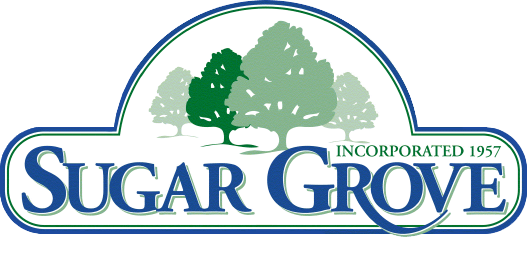Yard Drainage and Flooding
Overview
Your yard plays an important role in protecting your home from flooding. A properly graded yard can minimize minor drainage problems and prevent more serious flooding conditions. Before most homes in Sugar Grove are built, a detailed plan for how the yard would be graded to provide proper drainage of stormwater was developed by the builder and their engineer. The grading plan for your property may also have been part of an overall stormwater plan for your subdivision.
Proper Yard Grading
In general, a properly graded yard will have some or all of the following characteristics:
- Ground sloping away from the house – the ground surrounding your home should be graded away from your house’s foundation to ensure that stormwater flows away from the house and not towards it.
- Pavement sloping away from the house – driveways, sidewalks and patios should be graded away from your house’s foundation to ensure that the stormwater flows away from the house and not towards it.
- Drainage path towards the Village’s Stormwater Management System – stormwater runoff from your yard should have an unobstructed path towards the Village’s system. Many residential properties have swales in the side and rear yards which carry water towards inlets within the yard, a neighboring yard, or the street. Some properties are graded such that the stormwater can flow directly into a creek, ditch or basin.
Your Yard’s Role in the Stormwater Management System
All yards are a part of the Village’s Stormwater Management System. In most locations, stormwater from one yard is intended to flow onto and through another yard, either down slopes or within swales and ditches, to reach other features within the system, such as storm sewers or basins.
While all yards are a part of the system, some yards have key features which play a critical role in the Stormwater Management System. The components of the Village’s system described below are often present on residential property, sometimes unbeknownst to the homeowner. These features are typically located within a dedicated easement.
Storm Sewers – Many residential properties have an inlet on the surface covered by a grate that empties into a storm sewer pipe below ground which transports the water away. Yard inlets are typically intended to collect the stormwater from not only the yard where it is located, but also from the adjacent properties.
Detention Basin – A detention basin is an area where stormwater may be quickly collected but slowly released to minimize the impact to the surrounding area. When located on residential property, detention basins are not typically located solely on one property but rather on a portion of each of several adjoining properties, usually in the rear yards. These basins are typically a depressed turf area.
Overflow Routes – During an unusually long or heavy storm event, the amount of stormwater runoff may exceed what the swales and ditches, storm sewers and detention basins can accept. A network of overflow routes including residential side and rear yards has been established to allow the excess runoff to reach creeks, streams and the river without damaging structures.
Grading and Drainage Changes
Proper maintenance of the grading of your yard can minimize minor drainage problems and prevent more serious flooding conditions. The homeowner is responsible for maintaining the grading of their yard, including any features of the Stormwater Management System located within the yard.
Yard grading often changes over time due to both natural and man-made causes. The following situations can impact yard drainage by changing the grading or obstructing the intended stormwater drainage path:
Natural Changes
- Ground Settlement – The ground surrounding your home, particularly the area close to the house’s foundation, may settle overtime. This could cause the ground or any pavements to slope and direct stormwater towards your home. Settlement could also result in isolated low spots throughout your yard where water may collect.
- Erosion – Heavy rainfall or sump pump and downspout discharge could cause soil erosion resulting in isolated low spots where water may collect.
Man-made Changes
Landscaping – The installation of landscaping, including planting beds, berms, and retaining walls, is the most common man-made change to yard grading and drainage. All of these activities could change the yard grading and potentially obstruct the intended path for drainage of stormwater from within the yard and from adjacent yards.
Home and Yard Improvements – Many common home and yard improvements could change yard grading and potentially create obstructions to the intended stormwater drainage path. Examples of common improvements that could impact yard grading and drainage include:
- House Additions
- Patios or Decks
- Fences
- Sand Boxes or Swing Sets
- Sheds or Gazebos
- Pools
How Residents Can Help
Know Your Yard
Homeowners should know and understand how stormwater drains within their yard and if their yard is intended to drain onto or through a neighbor’s yard or if adjacent yards are intended to drain towards their yard. Homeowners should also know what features of the Village’s Stormwater Management System are present on their property. Key features, such as storm sewers, overflow routes, and basins, are typically located within dedicated stormwater management easements. The property’s plat is a good place to check if any of these easements have been dedicated on the property.
Consider Stormwater When Making Improvements
When planning a home or yard improvement project, consider how the grading of your yard and the drainage of stormwater may be impacted not only for your yard, but for your neighbors’ yards as well. Obtain any required permits and be careful not to alter the grading or create obstructions within swales, overflow routes or detention basins.
Keep it Clear
Ponding of stormwater within a yard often occurs due to clogged storm sewer inlets. If there is an inlet in your yard, residents are asked to keep this drain clear of all obstructions including, leaves, grass and debris. Debris at storm sewer inlets also build-up after a storm event, which is a good time to check the inlet to make sure that the system will work well in the next storm. If you cannot clear the debris yourself, please contact (630) 391-7230 to report the location.
Never Dump Into a Storm Sewer Inlet
It is important to never dump any debris, including but not limited to landscape waste, garbage or chemicals into a storm sewer inlet. While bulky materials can cause flooding, chemicals and other wastes that are dumped into a storm sewer eventually drain into the river, which threatens fish and wildlife and pollutes the water. If you observe this violation, or to find out how to properly dispose of waste products, please contact (630) 391-7230.
Be Patient After Rain Events
Following any rain event, stormwater may collect and form ponds in swales and low spots within yards. This can be a concern for many residents as it makes these areas of their yards unusable or they become concerned about the grass. Typically, water can pond over grass for 72 hours before impacting the health of the grass.







